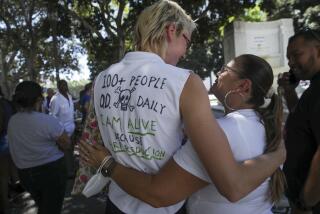Mortality Study Finds Tobacco Is No. 1 Culprit
- Share via
In the first examination of its kind of death in the United States, government researchers report today that although heart disease and cancer may be listed as the nation’s leading killers, the biggest underlying cause of death is in fact tobacco use.
The authors came to the startling conclusion that nearly half of the 2,148,000 deaths in 1990 could have been prevented through behavioral changes such as stopping smoking, eating more healthfully, exercising more, shunning alcohol and practicing safe sex.
But the research, published in today’s Journal of the American Medical Assn., singled out tobacco as the No. 1 culprit in causing death. It found that smoking contributed to the deaths of 400,000 people in 1990--more than the total deaths caused by drug use, firearms, irresponsible sexual behavior and cars.
“People may not realize the extent (to) which deaths among Americans are preventable,” said Dr. J. Michael McGinnis, who heads the Office of Disease Prevention at the U.S. Department of Health and Human Services and is the study’s lead author.
The JAMA article, which is the first study to rank the fundamental causes of death, comes as the Clinton Administration is pushing health care reform as a way to cut medical costs. The study suggests, however, that simply giving all people access to care will not be enough to reduce the nation’s medical bill. True savings will come only when people trade their unhealthful habits for healthful ones.
“When you come up with half the total number of deaths in this country are preventable, that people can do something about, the implications are enormous from an economic point of view,” said Dorothy Rice, a medical economist at UC San Francisco. “We still have a host of public health problems that simply will not be solved by comprehensive universal health care.”
The government estimates that the nation will spend $900 billion on health care this year--about $14,000 for a family of four. But only 5% of that is devoted to prevention.
“There are two messages here, one is to the individual and one is to society,” McGinnis said. “To the individual, the message is, ‘You can do a great deal to control your own health destiny.’ To society, the message is, ‘If we want to get serious about controlling premature and unnecessary and costly death and illness, we need to . . . invest heavily in health promotion and disease prevention.’ ”
McGinnis and his co-author, Dr. William H. Foege of the Carter Presidential Center in Atlanta, examined the major external factors--those that are not genetic, but are instead a product of environment--that contribute to death. They looked at circumstances that people can control, such as what they eat and drink, as well as those they cannot, such as “microbial agents”--germs that cause tuberculosis and other illnesses--and toxic agents, including synthetic chemicals and other pollutants.
In examining death certificates from 1990, the researchers looked beyond the diseases and illnesses listed as cause of death to the reasons people may have gotten sick in the first place. They found that smoking contributed to 19% of all deaths in the nation, including those from a wide variety of cancers, heart disease, stroke, low birth weight and burns.
Not surprisingly, this finding drew criticism from a spokesman for the Tobacco Institute, who said the study’s findings about smoking are not reliable and based on faulty methodology. “I think the statistics have demonstrably more rhetorical than practical value,” said the institute’s vice president, Walker Merryman.
After tobacco, the study ranked poor diet and lack of exercise as the leading causes of death. These habits accounted for 300,000 lost lives, the study said, by increasing the incidence of such illnesses as stroke, diabetes and colon cancer. Sedentary lifestyles were responsible for nearly one quarter of all deaths from chronic diseases, the authors said.
Misuse of alcohol helped kill 100,000 people, the researchers found, while drug abuse accounted for 20,000 deaths. Firearms resulted in 36,000 deaths--including 16,000 murders, 19,000 suicides and 1,400 accidental killings. In five states and the District of Columbia, more people die as a result of firearms than in car crashes, the study said.
Risky sexual behavior is one of the fastest-growing causes of death. In 1990, 30,000 deaths were attributed to unprotected sex--5,000 infants who died after unintended pregnancies, 4,000 people who died of cervical cancer, 1,600 who died of sexually acquired hepatitis B and 21,000 who died of AIDS. That figure was an increase of 20% from the previous year.
These numbers confirm what public health experts have been preaching for years--that behavioral changes can have a huge impact on reducing disease and preventing death.
Dr. Lester Breslow, dean emeritus of the UCLA School of Public Health, said the JAMA article confirms the results of his own studies in Alameda County 30 years ago and provides important backing for the notion that death should be viewed as a product of lifestyle, and not solely as a result of disease.
Death in the U.S.
Here is a look at the leading underlying causes of death in the United States in 1990.
ESTIMATED NUMBER PERCENTAGE OF CAUSE OF DEATHS TOTAL DEATHS *Tobacco 400,000 19% *Diet/activity patterns 300,000 14% *Alcohol 100,000 5% *Microbial agents 90,000 4% *Toxic agents 60,000 3% *Firearms 35,000 2% *Sexual behavior 30,000 1% *Motor vehicles 25,000 1% *Illicit use of drugs 20,000 Less than 1%
Source: Journal of the American Medical Assn.






